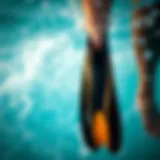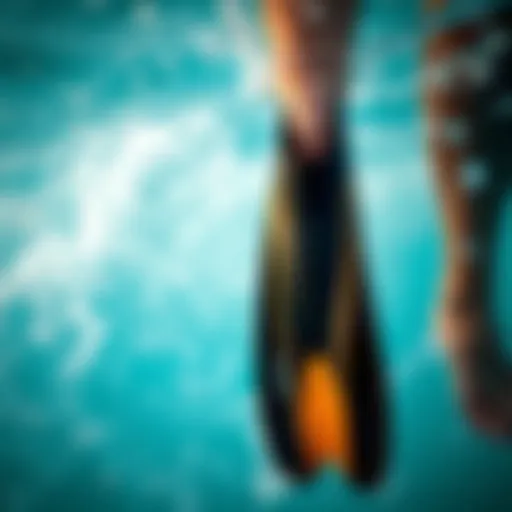Understanding Wind Currents' Impact on Surfing
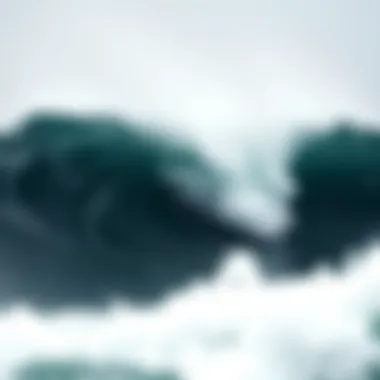

Intro
Surfing is not just about riding waves; it’s an intricate dance with nature, primarily influenced by wind currents and the ocean's temperament. Understanding these currents can turn a mediocre surfing experience into something extraordinary. Every swell has its genesis, often tied to global wind patterns that sculpt the seas and create the perfect break. Without grasping how these elements interact, a surfer may find themselves battling against the very forces that could otherwise propel them to glory.
From the furious winds churned up by storms in the North Atlantic to the gentle breezes along the Hawaiian coast, wind currents shape wave conditions all around the globe. These currents don't just affect the surfable waves but also determine where surfers decide to paddle out. In this article, we will peel back the layers of wind dynamics, examining how they feed into wave formation and ultimately influence surf conditions.
We aim to equip every surfer — from the newbie learning the ropes to the experienced wave rider — with a deeper understanding of the ocean’s behavior. Let’s delve into how these natural phenomena come into play when it's time to catch that ideal wave.
Surfing Techniques
Beginner Tips for Getting Started
As a novice surfer, understanding how to read the wind and ocean currents can significantly enhance your abilities. Here are a few key principles:
- Observe the Wind Direction: The direction in which the wind blows can determine how the waves behave. Generally, offshore winds, which blow from the land to the sea, clean up the waves and help them form perfectly.
- Pick the Right Time: Look for the surfing conditions forecasted to have favorable winds. Tools like Windy or Magicseaweed can provide real-time wind and wave data, aiding in your planning.
- Practice Your Paddling: Strong paddling skills are essential. Windy conditions can create choppy waters, making it necessary to paddle harder just to maintain your position.
Advanced Maneuvers and Tricks
Once you've conquered the basics, the next step is perfecting technique and exploration of advanced moves. Skilled surfers often take advantage of wind conditions to enhance their performance:
- Utilize the Wind for Speed: When executing tricks, use the wind to help increase momentum. This becomes especially useful when attempting aerial maneuvers.
- Read the Wave Dynamics: Understanding how wind affects wave break pattern can lead to better positioning on the board, which is crucial for executing tighter turns or radical drops.
- Take Advantage of Wind Swells: Learning how to read swells caused by wind can give you an edge. These swells can generate exciting opportunities for complex tricks.
"The ocean is a school, and every wave teaches a lesson about the elements — embrace the wind, and you’re halfway there."
Surfboard Selection
Choosing the Right Board for Your Style
Selecting the right surfboard is always a central part of surfing. Understanding wind and wave interactions is vital here as well. Choose a board that complements how the wind affects the surf:
- Shortboards: Typically preferred by those chasing fast, agile rides. They’re best used in conditions where wind is less intense, allowing for control in tricky waves.
- Funboards: A solid choice for beginners or intermediate surfers, offering a forgiving ride that adapts well to various wind conditions.
- Longboards: These are excellent in calmer winds, providing stability and ease in paddling out, ideal for leisurely rides.
Surfboard Maintenance and Care
To ensure a long life for your surfboard, maintenance is crucial:
- Regular Inspections: Check for dings or cracks, especially after rough surfing sessions. Wind and surf conditions can take their toll on your equipment.
- Wash After Use: Rinse off any saltwater and sand to avoid deterioration of your board’s materials.
- Store Properly: Avoid leaving your board in direct sunlight for prolonged periods, as UV rays can weaken and warp it over time.
Understanding these nuances not only optimizes your surfing experience but enhances safety in the unpredictable dance of ocean dynamics. Surfing doesn't just rely on your skills; it’s a complex interplay of natural environmental factors that deserve your attention. Stay tuned as we continue to unravel the powerful winds and their waves.
Prelims to Wind Currents
Wind currents, often overlooked by casual beachgoers, play a pivotal role in shaping our surfing experience. Understanding these currents isn't just an academic exercise; it holds practical importance for surfers who want to harness the power of the oceans. Whether you’re a seasoned pro or a weekend warrior, comprehending wind currents can enhance your time in the water.
Definition of Wind Currents
At its core, wind currents are large-scale air movements that occur in the Earth’s atmosphere. They are caused primarily by differences in temperature and pressure, which arise from the Sun's uneven heating of the Earth's surface. Think of the atmosphere as a giant conveyor belt, continuously in motion, transporting air from high-pressure zones to low-pressure areas. This flow is influenced by multiple factors, including the Earth's rotation and local topography, which adds layers of complexity to wind patterns.
Wind currents can be classified into different types based on their location and behavior. For example, trade winds dominate tropical regions, while westerlies prevail in mid-latitude areas. The global circulation system, including Hadley cells, Ferrel cells, and polar cells, governs how these winds interact with ocean surfaces, leading to significant implications for weather and climate.
Importance of Wind Currents in Surfing
Why should surfers bother with wind currents? The answer is multifaceted. First and foremost, wind currents directly impact wave formation. When winds blow across the water, they transfer energy to the surface, generating waves. The direction, speed, and consistency of these winds can determine whether a surf break is firing or flat.
Moreover, understanding wind currents can help surfers make more informed decisions about when and where to surf. For instance, offshore winds that blow from land to sea can groom waves, making them cleaner and hitting the reefs just right, while onshore winds can chop up waves, making for less desirable surfing conditions.
By being aware of how wind patterns behave in certain regions, surfers can optimize their sessions, ensuring they catch the best waves during peak conditions. Ultimately, knowledge about wind currents enhances not just individual performance but also safety in the water, as surfers are better equipped to navigate changing ocean conditions.
“The ocean is a living entity, and understanding its currents will not only enhance your surfing experience but could also save your life.”
In the next sections, we will delve deeper into the formation of these wind currents and analytically explore their broader influence on surfing, completing the picture of this crucial relationship between wind and waves.
Formation of Wind Currents
Wind currents play a fundamental role in shaping our weather patterns and, consequently, our surfing experiences. Understanding how these currents form is crucial for surfers looking to navigate the waves effectively. This section delves into the intricate factors that contribute to the creation of wind currents and categorizes the different types of wind systems that exist globally.
Key Factors in Wind Current Formation
Wind currents are not just random movements of air; they are influenced by several key factors that together create distinct patterns across the globe. Let’s explore these factors, looking at how they contribute to the formation of wind currents and ultimately affect our time spent on the water.
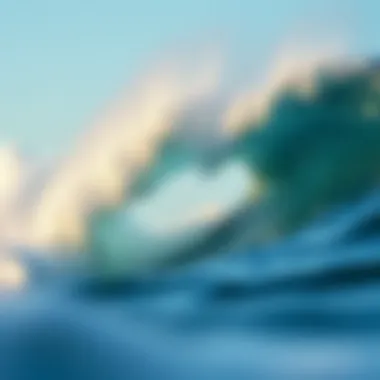

Temperature Differences
Temperature differences are essential for wind formation. This aspect occurs when the sun heats the Earth’s surface unevenly. For example, the ground heats up faster than the oceans during the day. This creates warm air that rises over land while cooler air moves in to take its place, creating wind.
- Key Characteristic: These differences are often more pronounced on hot summer days. The results can lead to strong local wind patterns.
- Benefits: For surfers, understanding these patterns can be advantageous. Knowing when to expect stronger onshore or offshore winds can enhance the surfing experience, as windy conditions can create better waves.
- Unique Feature: One unique aspect is the local sea breezes that are generated near coastlines. They can vary in intensity based on the temperature contrast between land and sea, providing ideal conditions for surfing. However, if mismatched, they could also flatten the surf.
Earth's Rotation
The Earth's rotation significantly influences wind currents through the Coriolis effect. This effect causes winds in the northern hemisphere to curve to the right and those in the southern hemisphere to curve to the left. As a result, it creates distinct wind patterns that shape climate and surfing conditions globally.
- Key Characteristic: The Coriolis effect is responsible for the rotation of large wind systems, like cyclones and anticyclones, playing a vital role in their development.
- Benefits: Understanding how the Earth’s rotation affects wind can help surfers predict changes in offshore winds, which are crucial for wave quality.
- Unique Feature: The way Earth’s rotation influences jet streams is another significant aspect. These high-altitude winds can affect storm movements, influencing wave patterns at the surface.
Topographical Influences
Topographical features such as mountains, valleys, and coastal regions affect wind currents in remarkable ways. For instance, air is forced to rise over mountain ranges, which can create wind patterns that affect the weather and surf conditions far downwind.
- Key Characteristic: Mountains can create barriers or channels for winds, enhancing or diminishing their strength depending on the landscape.
- Benefits: Surfers can utilize these topographical features to their advantage. For example, understanding how a coastline interacts with wind can lead to discovering the best surf spots.
- Unique Feature: One might also note how certain coastal configurations amplify swells driven by prevailing winds, leading to better wave conditions. However, steep coastal cliffs can block winds, leading to flat surf in certain areas.
Types of Wind Currents
Recognizing the types of wind currents can further enhance surfers' knowledge of wind patterns. Within the three primary categories, each carries distinct traits and generates varying effects on coastal wave formation.
Trade Winds
Trade winds are persistent winds that flow toward the equator from the northeast and southeast trade wind belts. They are known for creating reliable conditions in equatorial regions.
- Key Characteristic: These winds are generally steady and consistent, often providing predictable wave patterns.
- Benefits: Surfers flock to areas affected by trade winds for their reliable surf conditions, especially in locations like Hawaii and the Caribbean.
- Unique Feature: The reliability of trade winds can lead to excellent surfing conditions, especially during specific seasons when they are at their peak.
Westerlies
Westerlies are winds that blow from the west in the mid-latitudes. These winds are instrumental in creating large ocean swells and delivering them to surf spots along coastlines.
- Key Characteristic: Unlike trade winds, westerlies can be more variable in strength and direction but are typically stronger during certain seasons.
- Benefits: They create dynamic wave swells, which are crucial for experienced surfers hunting for powerful conditions.
- Unique Feature: The swells generated by westerlies often travel long distances across the ocean, impacting surf spots even if they are far from the source.
Polar Easterlies
Polar easterlies blow from the polar regions and can significantly affect climate and ocean conditions, though their impact on surfing is less direct than trade winds and westerlies.
- Key Characteristic: These winds are cold and dry, forming over ice and snow-covered areas.
- Benefits: While not usually associated with ideal surfing conditions, they can occasionally influence larger storm systems that create suitable waves in susceptible areas.
- Unique Feature: They often play a role in seasonal changes of global ocean currents, indirectly affecting wave formation patterns.
Understanding these factors and types of wind currents is crucial for surfers wanting to harness the potential of the ocean effectively. Knowing when and where to catch the best waves can be the difference between a good day and a fantastic one on the water.
"Wind currents are not just background players; they are the forces shaping our surf experience."
With this foundational knowledge, surfers can better anticipate conditions that either enhance their experience or pose challenges during their time in the ocean.
The Global Wind Currents Map
Understanding the global wind currents map is crucial in appreciating how wind patterns dictate surf conditions across many regions. The mapping of these wind currents provides surfers with valuable insights into where and when to catch the best waves. By visualizing the intricacies of these currents, one can anticipate ocean influences, enabling more strategic planning for surfing outings.
Visual Representation of Wind Currents
The visual representation of wind currents serves as a critical tool for surfers and ocean enthusiasts alike. Through various mapping techniques, currents can be depicted in colors indicating their speed and direction. A well-crafted wind map can allow surfers to comprehend the changing conditions of local surf breaks. For example, a map demonstrating the position and intensity of trade winds can give key indicators about likely wave sizes and conditions. Surfers can easily identify which days will be optimal based on visual cues.
Regional Wind Patterns
To gain a comprehensive grasp of wind currents, it's essential to discern the varying regional patterns as they exhibit unique characteristics.
Equatorial Regions
The equatorial regions are marked by consistent trade winds that blow from east to west. This area thrives in stable weather conditions, which contribute to balanced wave dynamics. The prominent feature of these regions is the predictable wind patterns that can help surfers find reliable tides. Surfers flock to these spots primarily for their steady waves and warmth. However, the disadvantage lies in tropical storms that can unexpectedly arise, making forecasting a necessity.
Mid-Latitudes
In the mid-latitudes, the wind systems are far more variable than in the tropics. This area shows a strong interplay between different weather systems, leading to diverse wave conditions. The shifting westerlies here create mixed wave patterns that can either become choppy or result in clean overhead sets. This diversity makes mid-latitudes a fascinating place to surf, but unpredictability also means local knowledge is essential.
Polar Regions
The polar regions bring an entirely different scenario to the table. Winds in these areas can be fierce, being influenced by the cold temperatures, arctic fronts, and polar cyclones. A noteworthy feature of these regions is their seasonal changes, which affect surf conditions dramatically. While the cold water and brutal conditions deter many surfers, those equipped to handle it discover a unique and rewarding experience. However, the lack of consistent waves makes it a less practical choice for regular surfers seeking dependable conditions.
In summary, understanding the global wind currents map highlights the importance of regional variations and their influences on surfing. Each area, from equatorial regions through to polar zones, presents unique opportunities and challenges for surfers, underpinning the essence of wave riding based on wind patterns.
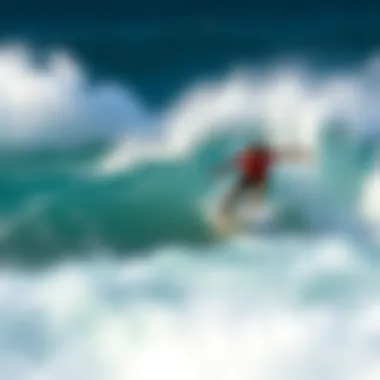

Impact of Wind Currents on Ocean Waves
The relationship between wind currents and ocean waves might seem like a straightforward concept, but it's layered with complexities that are crucial for understanding the surfing experience. Wind currents, which are driven by atmospheric conditions and earth's rotation, play a monumental role in shaping not just the physical characteristics of waves, but also their behavior and patterns across different surf spots.
Wind currents are like the unseen hand that stirs the ocean's waters, influencing wave creation and dynamics in various ways. Surfers benefit from knowing how these currents affect not only the size and strength of the waves but also their direction and consistency. Recognizing these factors can drastically affect performance and safety while riding the waves.
Wave Formation and Dynamics
The formation of waves is largely a dance between wind and water. When wind blows across the surface of the ocean, it transfers energy to the water, which leads to the creation of waves. This process is not merely about size; it's about the intricate dynamics of how waves propagate and break. The initial wind speed, duration, and fetch—the distance over which the wind blows—are essential in determining the energy imparted to the waves.
For instance, a gentle breeze creates small ripples, while a fierce storm can generate colossal swells that travel miles across the ocean. These waves change as they approach shore, influenced by depth and local topography. Hence, the same wind current can produce vastly different surfing conditions at various locations.
"Understanding wave dynamics is just as important as knowing your board or paddling technique. It can make all the difference between a good ride and a wipeout."
Relationship Between Wind and Wave Height
The height of waves is directly correlated to the strength of the wind. Strong winds vigorously moving over a vast stretch of water tend to generate higher waves. However, this relationship is nuanced. While a robust wind can lead to large waves, it also can create chaotic surf conditions that might not be suitable for all surfers.
Conversely, lighter winds can result in smaller, cleaner waves, which are often more favorable for less experienced surfers or beginners. In many surfing hotspots, local surfers eagerly glance at the wind conditions, knowing full well how it impacts wave size and quality.
Key points of consideration include:
- Wind Speed: Higher speeds lead to bigger waves.
- Wind Direction: Offshore winds smooth out waves, while onshore winds can create choppy conditions.
- Duration: The longer wind blows over the water, the more energy it transfers—thus larger waves.
- Fetch: Greater fetch results in more powerful waves as energy builds up.
Understanding these elements helps surfers gauge the best times to hit the surf. Knowledge of wind-driven wave dynamics not only enhances the experience but also ensures a safer and more enjoyable time in the water.
Surfing Conditions and Wind Currents
When it comes to surfing, the role of wind currents cannot be overstated. Surfers are often at the mercy of the ocean's whims, and understanding these wind movements is key to maximizing both safety and enjoyment. Surfers who have a firm grasp on wind currents are better equipped to make sense of the waves they encounter. It’s like having a cheat sheet for the ocean's behavior. Knowing how wind influences surf conditions can drastically change the experience one has at the beach.
Wind currents affect not only the size and shape of waves but also their consistency and timing. For instance, a gentle offshore wind can make waves clean and organized, creating an ideal environment for surfing. On the flip side, strong onshore winds can chop up waves, making them less rideable. So, a surfer who pays attention to prevailing winds will likely have more success in picking the right time and place for a session. This makes the topic utterly indispensable for anyone who takes to the waves, from beginners to seasoned pros.
How Wind Affects Surfing Conditions
Wind plays a critical role in shaping how waves form and the conditions surfers face. The science behind it is pretty straightforward: as wind blows across the ocean's surface, it transfers energy to the water, which in turn creates waves. The stronger the wind, the more energy is given to the water, resulting in larger and more powerful waves. This can be great when seeking adrenaline-filled rides, but it can also lead to tricky conditions that require advanced surfing skills.
Consider the following factors on how wind specifically affects surf conditions:
- Direction: Offshore winds, blowing from land to sea, help to maintain wave shape, resulting in cleaner and peaking surf. Conversely, onshore winds create a turbulent and messy surface, which can ruin the shape of waves and make them harder to ride.
- Intensity: Wind strength can determine the severity of the waves. A mild breeze might offer just enough push to create pleasant surf, while gale-force winds could drastically increase wave size, aligning with the skills of more advanced surfers.
- Duration: The length of time that wind blows in one direction can lead to more consistent surf. Bumpy surf may result from variable winds, which make for unpredictable wave conditions.
By keeping an eye on these elements, surfers can better interpret how wind patterns shape the surf they’ll experience that day.
Optimal Wind Conditions for Surfing
For those looking to catch the best surf, being aware of optimal wind conditions is crucial. Generally, surfers seek clean, organized waves that arise from favorable wind conditions. Here are several factors to consider that can help surfers pick their battles wisely:
- Offshore Winds: Ideal conditions often arise when the wind blows offshore. This means that the wind is blowing from the land toward the ocean. Waves tend to stay well-formed, giving surfers a better opportunity to ride smoothly and gain speed. The days when you see the waves breaking perfectly and lifting cleanly are usually the result of offshore winds.
- Light Winds: Sometimes, less is more. Light winds reduce the likelihood of chop on the water surface, which can disrupt wave formation. Flat, calm conditions can create a serene surfing environment, especially for beginners who are just finding their footing.
- Swell Direction Alignment: It's not just about the wind; how the wind interacts with the swell affects everything. The angle of the swell relative to the wind direction can have a profound impact on wave shape and quality.
By honing in on these optimal conditions, surfers can strategically plan their sessions, making every trip to the water worthwhile. Understanding the intricate relationship between wind and surf conditions not only leads to better surfing performance but can also enhance the overall surfing experience, keeping both excitement and safety at the forefront.
"Experience has shown us that the best surf may be just a gulp of wind away."
For further reading on how wind interacts with ocean currents, check out resources like National Oceanic and Atmospheric Administration and surf community forums on Reddit to glean insights from fellow surfers.
Regional Case Studies
Exploring regional case studies focused on wind currents offers surfers invaluable perspectives on how these currents influence the ocean's behavior at specific locations. Each area has unique characteristics that can alter wave conditions, making it essential for surfers to comprehend local wind patterns. These studies paint a clearer picture of how surfers can adapt their strategies depending on the region they find themselves in, allowing for improved performance and safety while riding the waves.
Wind Currents in Hawaii
Hawaii is known as the mecca for surfers, and understanding its wind currents is key to mastering local surfing conditions. The islands experience a combination of trade winds and unique geographical features that shape the surf scene.
The trade winds blow consistently from the northeast, helping to create the reliable swells that surfers crave. These winds not only dictate surf conditions but they also impact water temperature, marine life, and even the formation of coral reefs nearby. Locations such as the North Shore are especially influenced by these currents, leading to more challenging and powerful waves. Surfers should pay attention to the wind forecasts as they affect wave sizes and break patterns, making it essential for them to ride at the right time.
Wind patterns in Hawaii can change rapidly, so staying informed is crucial.
Influence of Trade Winds on Australian Surfing
Australia's extensive coastlines exhibit a variety of surf conditions influenced by the trade winds. The Great Barrier Reef, for instance, provides some level of protection against the forces of the surf. The east coast of Australia benefits from the persistent easterly trade winds, which can create fun, mellow surf conditions for recreational surfers and intense waves for the more seasoned rider.
Interestingly, these winds can also result in sea breezes that shift direction during the day. In the afternoons, surfers might find conditions becoming choppy due to onshore winds, thus altering their strategies. Knowledge of these trade winds provides surfers with the tools needed to narrow down the best surf spots and times to ride the waves. Some popular spots, notably Bondi Beach, can go from glassy to turbulent within a short time, depending on wind changes.
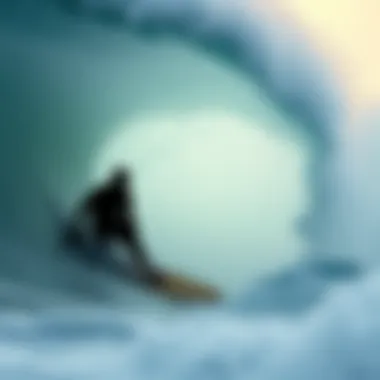

Understanding how trade winds shape the surf experience adds depth to any surfer's journey.
European Coastlines and Wind Patterns
In Europe, the coastal surfing landscape is diverse, with each country exhibiting unique wind and wave patterns. Places like Portugal and France benefit from the North Atlantic swells, bolstered by prevailing westerly winds. The phenomenon creates consistent surf breaks that attract surfers from around the world.
Regions such as Nazaré in Portugal offer monumental waves, often reaching up to 100 feet. Here, wind currents can create massive swells, drawing big wave surfers eager to test their limits. The influence of wind currents is profound; offshore winds are typically best for surfing, while onshore winds can lead to choppy waves that make for challenging conditions.
When surfing the coasts of Spain or the UK, surfers need to be particularly mindful of variable weather patterns that can shift rapidly. One minute it may be sunny, and the next a storm might roll in, shifting the winds and waves dramatically. Surfers must rely on their understanding of local wind patterns to stay safe and enjoy their sessions on the water.
"It’s not just about riding waves; it’s about knowing when and how to ride them."
In summary, regional case studies provide surfers with an in-depth understanding of how various wind currents directly affect their experience on the waves. By tailoring their approach based on these localized insights, surfers can enhance both their enjoyment and performance in the water.
Navigating Surf with Wind Knowledge
Understanding wind currents is akin to holding a compass in the world of surfing. It provides structure and gives you the tools to navigate the often unpredictable conditions of the ocean. Wind doesn't just play an invisible role; it actively shapes the waves, directly impacting surfers’ experiences. Knowing how to read the wind can be the difference between riding perfect swells and sitting idly on flat waters.
Some essential reasons for comprehending wind currents involve enhancing safety, optimizing performance, and predicting surf conditions effectively. When surfers grasp how wind alters wave dynamics, they can better identify the most conducive environments for catching waves, ensuring they're in the right place at the right time. This knowledge is not merely academic; it directly translates into a more fulfilling surfing experience.
Practical Tips for Surfers
- Monitor Wind Patterns: Before heading out, check reliable surf forecasts that include wind direction and speed. Apps like Windy provide real-time data to help you make informed decisions.
- Understand Local Winds: Every coastal area has idiosyncratic winds. For instance, the Oahu’s trade winds can turn the surf variable; knowing when they pick up and die down through the seasons can determine the difference between a good session and a great one.
- Time Your Sessions Wisely: Winds typically pick up during the daytime. Early morning surf is often blissful with lighter winds creating glassy conditions. Capitalize on those calm hours post-sunset too.
- Learn to Read Flags: Learn from local beaches; many places use flags to indicate conditions. Green might signal both great surfing and ideal wind conditions, while red could mean caution because of strong winds.
- Practice Safety: Always remember, stronger winds can lead to large surf. Stay aware of changing conditions and prioritize safety over the thrill of chasing bigger waves.
Using Wind Currents for Better Performance
Using wind currents to enhance surfing performance involves a bit of strategy and intuition. Surfers can harness favorable winds to ride longer, smoother lines. Here are a couple of ways:
- Seek Offshore Winds: Winds blowing from land to sea often signify clean, well-formed waves because they hold up better as they approach the shore. Facilities with offshore winds produce those picturesque, hollow breaks that surfers crave.
- Ride the Swell: When wind and swell are aligned well, it results in more powerful, steep waves that can increase your speed. Positioning yourself correctly in the lineup can significantly improve your ride.
In addition, becoming familiar with wind speed can help surfers develop better paddling techniques. Paddling against the wind calls for endurance, while surfing with it can offer that extra thrust to propel you forward. Undoubtedly, understanding how wind interacts with waves is a crucial part of being a competent surfer.
"Knowledge is the greatest weapon in a surfer’s arsenal. Recognizing wind patterns allows for greater connection with the ocean and could ultimately lead to a more satisfying surfing experience."
Navigating with this understanding turns the ocean from an unpredictable force into a canvas of opportunities, allowing surfers to paint their dreams on waves.
Future of Wind Current Studies
As the world grapples with ever-changing climate conditions, understanding wind currents is more than just academic interest for surfers—it's a matter of survival and performance. Knowing how these currents develop and shift can greatly improve not only surfing conditions but also safety at sea. It’s true what they say: knowledge is power. The future of wind current studies holds the key to unlocking that power, allowing surfers to ride the waves with confidence and skill.
Advancements in Technology
In recent years, technology has taken great strides in the field of meteorology and oceanography. Tools like satellite imagery and automated buoy systems have made it possible to track wind currents with remarkable precision. Employing these technologies, researchers can gather real-time data about wind speed and direction, wave patterns, and sea surface temperature. This wealth of information is invaluable.
- Predictive Modeling: Modern algorithms can analyze historical data and current conditions to predict how wind currents will react under varying influences. This isn't just fancy math; it gives surfers a heads-up on the best times to hit the beach.
- Mobile Apps: Today’s surfers are swiping through apps that use advanced meteorological data to provide instant reports on surf and wind conditions. With just a flick of a finger, surfers can access localized forecasts that save time and enhance their experience.
"Utilizing real-time data transforms your surfing—like having a crystal ball that reveals the best swells."
Implications for Surfing in Climate Change
The implications of wind current studies stretch far beyond individual surfing sessions; they touch on broader environmental issues. Climate change has a pronounced impact on wind patterns, which in turn affects wave dynamics and marine ecosystems.
- Erosion and Habitats: Changes in wind currents can lead to increased coastal erosion, affecting not just surfers but entire communities that rely on beach tourism. Altered habitats may trigger significant declines in marine biodiversity as local ecosystems struggle to adapt.
- Changing Conditions: Conditions that surfers have come to rely on can shift unpredictably as climate change progresses. Understanding these patterns helps surfers make informed decisions not just for themselves, but also for the health of the oceans and coastlines they cherish.
In summary, the future of wind current studies holds immense potential for enhancing the surfing experience while simultaneously addressing critical environmental concerns. Surfers who stay informed about these advancements and the broader implications of climate change will not only improve their performance but will also contribute to the stewardship of the ocean they love.
Ending
In wrapping up the discussion on wind currents and their influence on surfing, it’s crucial to reflect on how these natural phenomena not only shape ocean conditions but also determine the very experience of surfing itself. Understanding wind currents empowers surfers to navigate both familiar and new waters with greater precision. This knowledge transforms a casual ride into a strategic endeavor, where the surfer takes advantage of the wind to catch better waves and improve their performance.
Summary of Key Insights
As we've explored, wind currents are not merely background players in the oceanic stage but are central to the dynamics of wave formation. They interact with waves in various ways:
- Types of Winds: Different wind patterns lead to diverse wave types. For instance, the consistent trade winds in tropical regions create predictable conditions, perfect for surfing.
- Wave Height and Power: The relationship between wind and wave characteristics must not be understated. Strong winds create powerful waves, while gentle breezes offer more delicate surf conditions.
- Regional Variations: Locations like Hawaii, Australia, and Europe each harbor unique wind profiles, significantly impacting local surfing experiences.
Acknowledging these insights enables surfers to adapt their approach to the water. Understanding the underlying principles at play when they catch a wave allows them to ride with more confidence and expertise.
Final Thoughts on Wind Currents and Surfing
In the ever-evolving landscape of surfing, recognizing the patterns of wind currents opens the door to numerous possibilities. As climate change continues to reshape our environment, those who keep abreast of wind dynamics will find themselves on the cutting edge of surfing knowledge. Technology advances in surf forecasts and oceanographic studies allow surfers to make informed choices about when and where to surf the best waves.
Ultimately, the relationship between surfers and wind currents is a dance, a conversation of sorts with nature. Those who learn to read the whispers of the wind as it interacts with the ocean will not only improve their skills but also foster a deeper connection to the sea.
"To truly surf the waves, one must first understand how the winds whisper their secrets to the ocean."
For further reading on the physics of wind and its impact on surfing, check out more resources on websites like National Oceanic and Atmospheric Administration or Surfline. These platforms provide valuable insights into how wind systems affect surf conditions across various regions.


